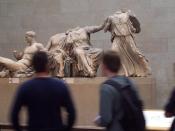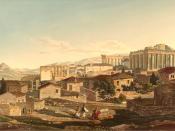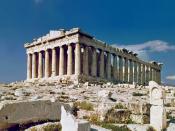A Home for Art
Art comes in many forms and styles; it comes from many different cultures, countries, and time periods. Art is the universal expression of soul. No art belongs to one person, race, culture or time; the opportunity to experience art is a God-given right. Thus, it should not matter where an art work is, because it holds the same intellectual and spiritual value in any setting.
In current events, the people of Greece are trying to claim rights to works of art that were taken from the Parthenon in 1816. The Parthenon was built in Athens hundreds of years before the Common Era, B.C.E. It was built by the Athenians in honor of their guardian goddess Athena. Two hundred years ago, a British aristocrat, visited this structure in hopes of catching a glimpse of its magnanimity but found it to be in poor form. In an attempt to "rescue" (movie) these priceless works from the apparent neglect of the Greeks, the British lord bought some of the sculptures and transported them back to England with him.
Since then, the sculptures have found their way to the highly prestigious British Museum, where they are protected and open to public viewing. The Grecian people have waited until now, 200 years later, to try to reclaim the art. The Greeks argue that the pieces belong in their "historical and culture environment" (movie). They think of the removed art as a source of cultural pride that they are missing in its absence. Hence, the people of Greece are making a strong push to have the art returned to its so called home.
As stated previously, art has no home; it belongs where it will be preserved and where its beauty and sacred value can be experienced by the public, not necessarily...


